Psoriasis is a chronic skin condition that cannot be completely cured. The disease requires symptomatic treatment to reduce the severity of manifestations and improve well-being. Psoriasis of the hands is a frequent localization of the pathology. It starts with the appearance of small plaques and can progress without the right treatment.
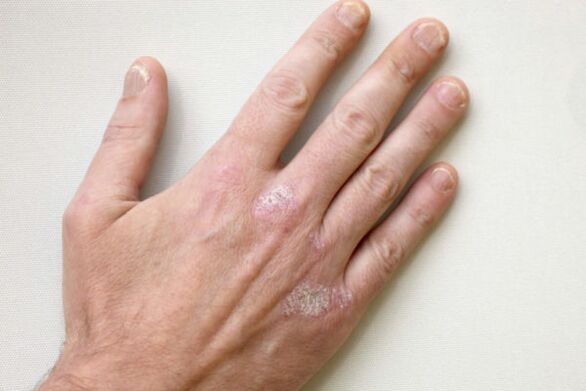
Causes and mechanism of development
Psoriatic plaques on the hands, especially on the fingers, significantly affect the quality of life. Despite the fact that the disease is not contagious, strange skin defects are alarming. Psoriasis is not the most pleasant disease, and not just because it looks like it, but also because of the risk of complications.
The exact etiology of the onset of this dermatological disease has not been elucidated. Experts identify risk factors that can affect the development of pathology. We know that psoriasis is not transmitted by contact, it cannot be infected by contact with the patient.
It is also important that he cannot be completely cured. Therefore, throughout life a person is forced to take supportive agents and carefully monitor the condition of the skin at different times of the year. Frequent exacerbations occur in spring and winter. Scientists include the following factors in the development of the disease:
- genetic predisposition;
- immunodeficiencies, decrease in the protective function of the body;
- frequent skin lesions of viral, fungal, bacterial origin;
- a sudden change in climatic conditions;
- chronic skin diseases, including birth defects;
- long-term use of certain medications, including anticonvulsants, antidepressants, and steroid hormones;
- psycho-emotional overload;
- metabolic disorders in the body.
Psoriatic plaques on the hands begin to appear in the small joints, between the fingers, near the phalanges. Pathological elements are more visible on the surface of the palms. Psoriasis from such a localization is very difficult to treat, since the hands are often in contact with household chemicals and other irritants.
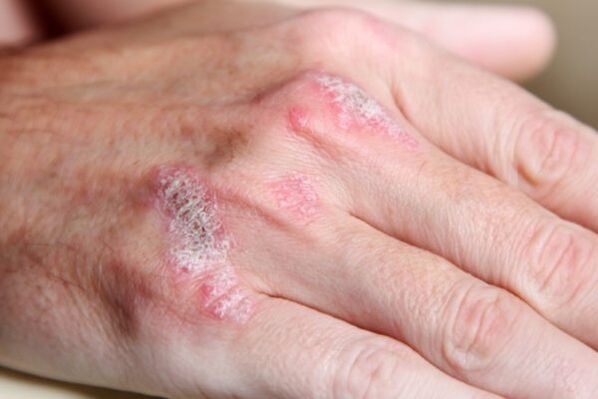
Risk group
The risk group for developing the disease includes men and women who are often confronted with other skin diseases. The likelihood of the disease increases when there have been previous cases of psoriasis in the family.
Pathology can occur in people with weakened immunity, in those who live in unsatisfactory living conditions. The risk group also includes those who, due to their activities, are forced to come into contact with harsh chemicals.
Clinical manifestations
The first signs at the initial stage of the disease will be unique pathological elements in the hands. Patches can appear on the hands, fingers, back of the palms. If the nails are involved in the pathological process, there is a risk of loss of sensitivity and the appearance of tissue edema.
Increased dryness of the skin causes cracks in the palms. There are signs of thickening of the epidermis, which look like calluses.
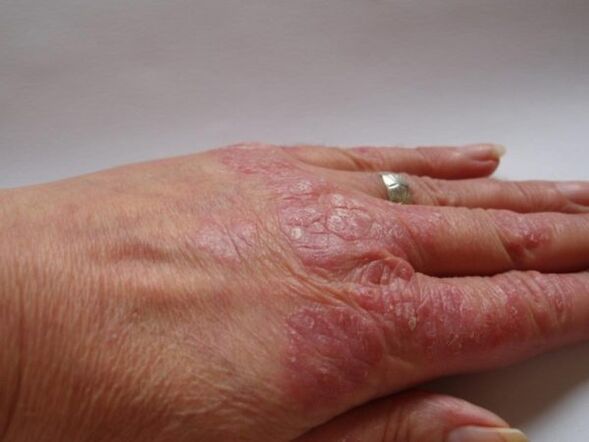
The main manifestations of psoriasis on the hands will be:
- increased dryness, pronounced redness of the skin;
- thickening of the epidermis, increased volume of the fingers due to edema;
- Cracking when the plate cracks
- sometimes there is a fusion of several elements with damage to healthy skin.
In winter and autumn, when cold days prevail, the disease manifests itself with intense peeling of the skin. Without treatment, there is a possibility of scratching your hands with an infection, then the symptoms are supplemented by signs of inflammation.
Forms of pathology
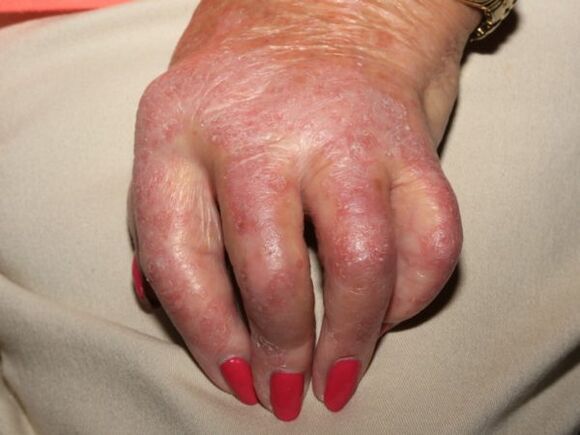
Psoriasis of the hands can take many forms:
- On the fingers. It is manifested by peeling, the formation of plaques, which are often inflamed. The aggravation occurs in winter. This often leads to complications.
- On the brushes. It occurs in 25% of patients, the signs are similar to psoriasis on the fingers, while the skin in the affected area becomes rough, areas of redness appear. The patient complains of constant discomfort, active peeling, itching.
- Palmar-plantar. Occurs in people who are engaged in hard physical labor. The soles of the feet and the palms are affected. Areas of rough skin look like solid calluses and cracks appear very often.
- arthropathic. Psoriasis occurs against the background of joint damage. The elements of the rash are located in the phalanges. In addition to external manifestations, the patient is concerned about pain in the joints during movement, and then at rest.
- Pustular. The palms and soles are affected. Stress and hormonal pathologies become risk factors. The rash has clear boundaries and pustules appear. The disease is often recurrent and difficult to treat.
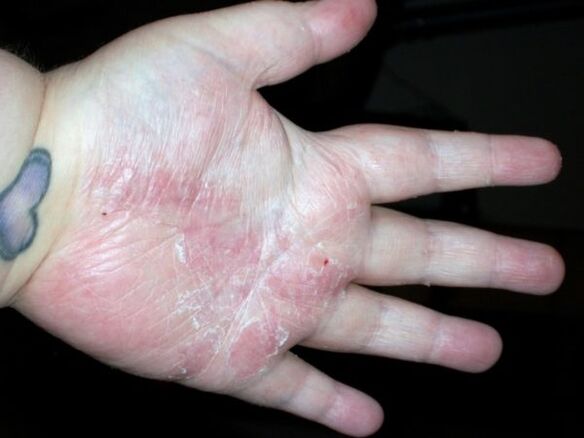
Each form of the disease proceeds in three consecutive stages - initial, progressive and stationary. After a cycle (going through 3 stages), the regression of the disease begins. At this stage, the clinical signs almost completely disappear. Treatment is aimed at making the regressive stage as long as possible, otherwise the disease cycle repeats itself indefinitely.
Differential diagnosis
Psoriasis of the hands is differentiated by pathologies such as lichen planus, Reiter's disease, syphilis, seborrheic and atopic dermatitis.
The hallmark of psoriasis during the examination will be the psoriatic triad, by the presence of which the doctor will be able to diagnose. It includes the phenomena of stearin stain, punctate bleeding and terminal film.
Processing methods
Although psoriasis cannot be completely ruled out, it must be treated to avoid complications and improve quality of life.
The main measures for the treatment of psoriasis on the hands:
- the use of skin care products to hydrate and soften the skin;
- take antihistamines to relieve itching;
- take drugs to increase immunity;
- additional use of homeopathic remedies.
For psoriatic lesions, physiotherapy and photochemotherapy may be prescribed. When psoriasis is accompanied by joint diseases, pain relievers from the group of nonsteroidal anti-inflammatory drugs are used.
Depending on the stage of the disease, the dermatologist will prescribe local anti-inflammatory drugs. It can be salicylic, ichthyol, sulphurous and tar ointments. To quickly relieve the symptoms of severe itching, hormonal ointments can be used; they cannot be used without the doctor's permission.
To soften and moisturize, you can use baby creams for sensitive skin, which contain herbal ingredients.
Preventative measures
General preventive measures to prevent exacerbations of psoriasis on the hands:
- the use of rubber gloves when cleaning the house when you must come into contact with detergents and cleaning agents;
- rejection of bad habits, good sleep and a balanced diet;
- daily care of the skin of the hands using natural cosmetics or pharmaceutical preparations;
- sunbathe regularly, ventilate frequently at home, walk in the fresh air, avoid stress;
- treat the skin with an antiseptic in case of accidental damage (it is not recommended to dress the wound for a long time);
- compliance with the Pegano diet, which consists of limiting meat dishes, sweets and adding more grains, vegetables and herbs to the diet.
Prognosis of the disease
The unpleasant psoriatic rash on the hands causes stress for many people. At the same time, the experiences only exacerbate the situation. Psoriasis can regress for a long time, but for this you need to follow the therapeutic and preventive measures prescribed by the doctor.
It is impossible to get rid of psoriasis completely, but proper skin care, adherence to a diet and the use of special creams will mask the symptoms of the disease as much as possible. Regardless of the manifestations of the disease, it is recommended to visit a dermatologist every few months to monitor the dynamics of the disease and correct the treatment regimen, if the condition requires it.























